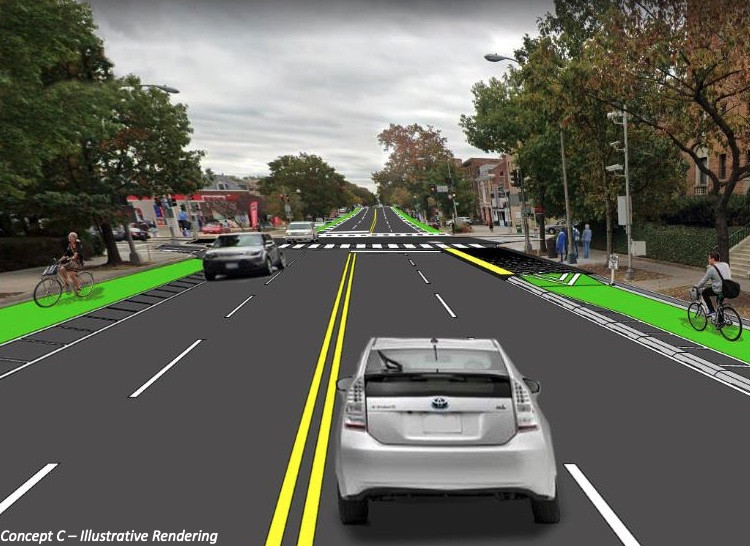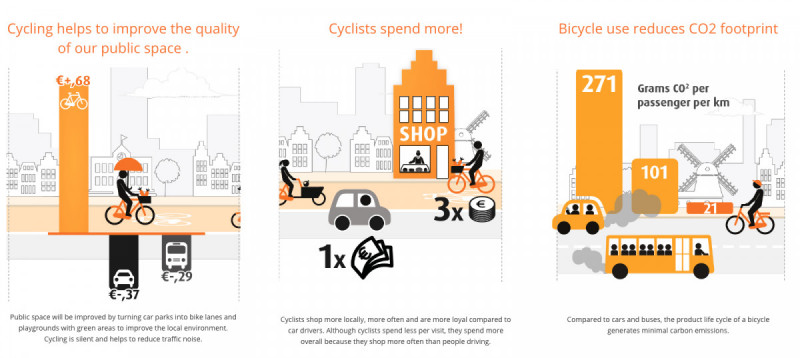Protected bike lanes on Connecticut Avenue could mean safer roads for all types of users

Cycling along Connecticut Avenue at the Cleveland Park shopping strip. Image from an ANC 3C presentation by DDOT.
Protected bike lanes could soon be coming to Connecticut Avenue NW, as the District Department of Transportation narrows down its preferred options in its Reversible Lane Safety and Operations Study. First envisioned to study if the dangerous reversible rush-hour lanes could be eliminated (there were more than 1,500 total crashes on this street between 2015-2019), DDOT expanded its scope to review whether a protected bike lane was feasible.
Many neighborhood residents (including the author, who lives at what would be the northern end of the proposed bike lane) support converting the 2.7 miles of road from what has been viewed by some as a rush-hour commuter route for Maryland drivers, to one more focused on those who live, shop and eat along the corridor. Installing this alternative could help return the Avenue to a corridor more closely aligned to its original vision of a series of streetcar communities.
DDOT has acknowledged that the reversible lanes will need to be eliminated to help promote safety, a core tenant of moveDC and Vision Zero. There are two preferred alternatives for the street. Here are the options and why the one with the protected bike lane offers residents, safer and more multimodal travel options.
A map of the study area. Image from an ANC 3E presentation by DDOT. 
Two preferred proposals
DDOT is in the home stretch of its decision-making process and plans public meetings in April before it settles on the preferred concept. It will then work up a 10% concept to present to the community this summer before it moves to finalize the design. DDOT started with at least seven different alternatives, including a no-build alternative, and narrowed those down to two preferred concepts, each of which was rated highest under DDOT’s scoring regime.
Concept B would not include bike infrastructure, and would simply eliminate the reversible lane, while having three lanes in each direction during rush hour, and a parking lane on each side of the street during non-rush hours.
Image from an ANC 3E presentation by DDOT. 
Concept C also would eliminate the reversible lane and include a protected bike lane in each direction, while limiting car traffic to two northbound and two southbound lanes at all times. The bike lane (and its buffer) would taper at spots to permit a left turn lane at selected intersections and parking/loading on one side of the street in commercial districts. (The parking and loading zones would be available even during rush hour.)
Image of Concept B from an ANC 3E presentation by DDOT. 
Image of Concept C from an ANC 3E presentation by DDOT. 
Expanding the network to more casual cyclists (to the left of the chart below) who would ride if there were protected bike lanes could be a boon to those who want to avoid car trips, families and less experienced cyclists, without even taking into account the explosion in electric bike users that previously would never have wanted to contend with the hills of Ward 3.
Bicycle design user profiles. Image from a Federal Highway Adminisration/USDOT report. 
I’ve attended lots of community meetings and heard some common objections. Here are some ideas for how those objections could be addressed
Focus the discussion on the project’s main goal – safety
Safety for all road users is the main focus of Vision Zero and a major goal of moveDC. Roads like Connecticut Avenue are the most dangerous for cyclists. An Outside Magazine article about 2020 cycling crashes found that 65% of cycling deaths happened on busy arterials without bike facilities. Both USDOT and National Association of City Transportation Officials (NACTO) – cited by DDOT in its moveDC public meetings - recommend protected bike lanes on these main traffic routes.
But pedestrian safety is also key. Getting bikes and scooters off the sidewalks, the only current place where they may be safely used, and into protected lanes makes for a safer walk. Pedestrians will also benefit from shorter distances crossing Connecticut Avenue. Buffered bike lanes will also provide a pedestrian refuge at many intersections and make crossing the sixty-foot wide boulevard less stressful.
Reducing travel lanes, like in the Concept C alternative, will also reduce speeding, noise and danger to all users, which adds to our quality of life. As we have seen during the pandemic, when cars have open space and multiple lanes, they tend to speed and drive with less caution, as borne out by the data showing increased crashes and fatalities. The lane reduction, and the resulting calmer traffic, benefits the people who live there.
Create better visuals so residents can see the benefits
Existing presentations of the Concept alternatives are geared to those well-acquainted with street design rather than the typical user. Depictions like one presented by DDOT for Concept 3 are the norm:
Image from an ANC 3E presentation by DDOT. 
Image from an ANC 3E presentation by DDOT. 
This 3D view in DDOT’s presentation of Concept C offers a convincing visualization how pleasant the bike ride looks here and how a raised bus stop would operate for cyclists and bus users. More images like these of each business district could be vital in helping residents and businesses better understand the potential improvements they will see.
Forecast for a post-COVID city
The data on car traffic impact DDOT has presented thus far yields very promising conclusions for the immediate future, all the way until 2045:
“The impacts of reducing the number of lanes along Connecticut Avenue during the peak hour, peak direction, by either one or two lanes, is manageable. Parallel and collector roadways can accommodate these modest increases in volumes.”
But the actual impacts during rush hour may be far less, as DDOT notes:
“The study does not take into account changes in traffic volumes, on a year-to-year basis, like we are experiencing during Pandemic conditions.”
DDOT acknowledges During public meetings their models use historical data even though the agency already knows traffic volume is reduced by the pandemic – it is down 50% on Connecticut Avenue during rush hours. It is noteworthy also that rush hour traffic capacity is the main focus of the traffic impact analysis, even though at other times the impact will be far less – another point DDOT does not emphasize in its presentations.
There is plenty of data indicating that a daily commute to a downtown core of offices is no longer the norm for a majority of companies, from transit agency commuting forecasts, to the specter of reduced car sales, to how companies are shedding their real estate footprints. The data indicates that more than 1/3 of all jobs can be done at home; if commuting is reduced even 10% in the coming years to the downtown core (likely a conservative estimate for DC) this marginal reduction would have a huge impact on the traffic and diversion data DDOT is modeling. DDOT needs to calibrate its data to reflect this possibility and show a range of potential traffic outcomes in its presentations.
Address the economic benefits to business
Another thing that can be amplified is the economic benefits of bike lanes. Some proprietors of local businesses may be concerned that having added rush hour parking will provide a net benefit to them. A recent study at Portland State University indicates bike lanes can have a positive impact on customer traffic for foodservice and retail businesses.
This infographic from Dutch Cycling Vision shows, also show there is a financial incentive for businesses to encourage bike lanes. Simple visuals like this that explain how consumers and businesses benefit from safer and accessible bike travel go a long way with community buy-in.
Image by Dutch Cycling Embassy 
Let’s talk about the parking issue
It’s no secret this will be the number one objection DDOT will face in installing a protected bike lane. The preferred option with the bike lane would remove an estimated 507 spaces along the 2.7-mile-long corridor. However, that is not the end of the story. Chevy Chase DC has more than 375 commercial spaces available in its business district, which is more than enough for residents driving to those locations. The preferred proposal with the bike lanes would also create parking spaces during rush hour on Connecticut Avenue that currently do not exist.
A parking study would also help. There are a number of ways to do a parking study, and DDOT has conducted them on other projects like that for the West Virginia Avenue Bike Lane or that done by a private firm in support of a recent Planned Unit Development. In Ward 3, DDOT itself has done a more recent analysis of on-street parking availability in its work proposing a protected bike lane on New Mexico Avenue, NW, 37th Street, NW and Tunlaw Road, NW:
Analyses like these are incredibly important. Understanding where cars will park if bike lanes are installed will be a key to the plan being acceptable to the widest number of residents.
An avenue for some, or one for all
A street that is safe and functional for all users, be they cyclists, pedestrians, or drivers, is not only the goal for the District but should be for all residents. The preferred plan with the bike lanes imagines a Connecticut Avenue NW for multimodal use, and prioritizes safety. As with any project, it’s hard to get consensus from a larger swath of people but things are looking good based on public statements from three of the neighboring ANCs.
DDOT will provide more details about the project at 5 pm Monday via a webinar hosted by Ward3Bikes and WABA.

